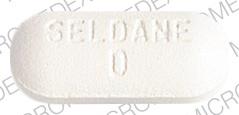Seldane-D Interactions
There are 566 drugs known to interact with Seldane-D (pseudoephedrine / terfenadine), along with 6 disease interactions, and 2 alcohol/food interactions. Of the total drug interactions, 119 are major, 435 are moderate, and 12 are minor.
- View all 566 medications that may interact with Seldane-D
- View Seldane-D alcohol/food interactions (2)
- View Seldane-D disease interactions (6)
Most frequently checked interactions
View interaction reports for Seldane-D (pseudoephedrine / terfenadine) and the medicines listed below.
- Abilify (aripiprazole)
- Acticin (permethrin topical)
- Adderall (amphetamine / dextroamphetamine)
- Adderall XR (amphetamine / dextroamphetamine)
- Advair Diskus (fluticasone / salmeterol)
- Advil PM (diphenhydramine / ibuprofen)
- albuterol
- Allegra-D 12 Hour Allergy & Congestion (fexofenadine / pseudoephedrine)
- Ambien (zolpidem)
- Ativan (lorazepam)
- BuSpar (buspirone)
- Cymbalta (duloxetine)
- Dilaudid (hydromorphone)
- Fentanyl Transdermal System (fentanyl)
- Flonase (fluticasone nasal)
- Klonopin (clonazepam)
- Lyrica (pregabalin)
- Neurontin (gabapentin)
- Norco (acetaminophen / hydrocodone)
- OxyContin (oxycodone)
- Paxil (paroxetine)
- Prilosec (omeprazole)
- Reglan (metoclopramide)
- Ritalin (methylphenidate)
- Strattera (atomoxetine)
- Vicodin (acetaminophen / hydrocodone)
- Wellbutrin (bupropion)
- Xanax (alprazolam)
- Zanaflex (tizanidine)
- Zantac (ranitidine)
Seldane-D alcohol/food interactions
There are 2 alcohol/food interactions with Seldane-D (pseudoephedrine / terfenadine).
Seldane-D disease interactions
There are 6 disease interactions with Seldane-D (pseudoephedrine / terfenadine) which include:
More about Seldane-D (pseudoephedrine / terfenadine)
- Compare alternatives
- Drug images
- Side effects
- Dosage information
- During pregnancy
- Drug class: upper respiratory combinations
Related treatment guides
Drug Interaction Classification
| Highly clinically significant. Avoid combinations; the risk of the interaction outweighs the benefit. | |
| Moderately clinically significant. Usually avoid combinations; use it only under special circumstances. | |
| Minimally clinically significant. Minimize risk; assess risk and consider an alternative drug, take steps to circumvent the interaction risk and/or institute a monitoring plan. | |
| No interaction information available. |
See also:
Further information
Always consult your healthcare provider to ensure the information displayed on this page applies to your personal circumstances.


